
 |
Home |
| • | Sravasti | • | Bodhgaya | • | Gaya | • | Kapilavastu | ||||
| • | Kaushambi | • | Kushinagar | • | Ladakh | • | Vaishali | ||||
| • | Lumbini | • | Nalanda | • | Nagarjunakonda | • | Nagarjuna sagar | ||||
| • | Orissa & Buddhism | • | Rajgir | • | Sanchi | • | Sankisa | ||||
| • | Sarnath | • | Sikkim | • | Ajanta & Ellora | • | Tabo | ||||
| • | Tawang | ||||||||||
Sravasti |
|
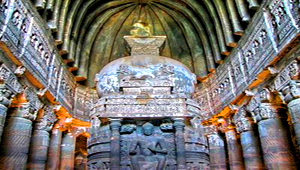 Sravasti, the capital of the ancient kingdom of Kosala, has the honour for sheltering Buddha for 24 rainy seasons in the Jetvana Gardens. Sravasti, the capital of the ancient kingdom of Kosala, has the honour for sheltering Buddha for 24 rainy seasons in the Jetvana Gardens. The city believed to be founded by the mythological king Sravast, has age-old stupas, majestic monasteries and several temples. Buddha is said to have performed some miracles here. This holy place also has the famous Anand Bodhi tree, an offspring of the one, said to have been planted by Buddha's main disciple |
|
Bodh gaya |
Top^ |
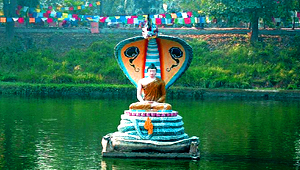 Bodh Gaya is the place where Gautama Buddha attained unsurpassed, supreme Enlightenment. It is a place which should be visited or seen by a person of devotion and which would cause awareness and apprehension of the nature of impermanence. Bodh Gaya is the place where Gautama Buddha attained unsurpassed, supreme Enlightenment. It is a place which should be visited or seen by a person of devotion and which would cause awareness and apprehension of the nature of impermanence.Siddhartha Gautama, the Buddha-to-be, had been dwelling on the banks of the Niranjana River with five ascetic followers for six years practicing austerities. Realising that austerities could not lead to realisation he abandoned them. His five ascetic companions disgusted at his seeming failure, deserted him and left for Sarnath. He then moved towards the village of Senani where he was offered rice milk by a Brahmin girl, Sujata. Accepting from a grass-cutter a gift of kusa grass for a mat, the Bodhisattva took a seat under a pipal tree facing east. Here he resolved not to rise again until enlightenment was attained. "Here on this seat my body may shrivel up, my skin, my bones, my flesh may dissolve, but my body will not move from this seat until I have attained Enlightenment, so difficult to obtain in the course of many kalpas". |
|
Gaya |
Top^ |
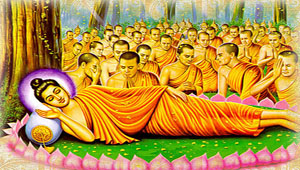 Gaya is one of the important holy places for Hindus and thousands of devotees throng this small town every year for pilgrimage. The main pilgrim center in Gaya is the Vishnu temple. Legend has it that this temple was built on Lord Vishnu's footsteps and is thus considered very sacred by the devotees. It is also believed by Hindus that if the final rights are performed in Gaya, the departed soul goes to heaven. Gaya is one of the important holy places for Hindus and thousands of devotees throng this small town every year for pilgrimage. The main pilgrim center in Gaya is the Vishnu temple. Legend has it that this temple was built on Lord Vishnu's footsteps and is thus considered very sacred by the devotees. It is also believed by Hindus that if the final rights are performed in Gaya, the departed soul goes to heaven. There are references to the town of Gaya in the Hindu epic of Ramayana. Sita, the wife of Lord Ram, one of the principal Hindu deities, is said to have cursed the Falgu River. Gaya was a part of the ancient Mauryan Empire in the 3rd century BC. Inscriptions belonging to King Ashoka, the great Mauryan ruler, have been found near Gaya. The small town of Gaya was the part of the great Mughal Empire in medieval times. After the disintegration of the Mughal Empire, it came under the rule of many regional kingdoms. In 1787 Queen Ahilyabai Holkar, who belonged to the ruling Holkar family of Indore, built the Vishnupad temple (Vishnupad, footstep of Lord Vishnu) in Gaya. |
|
Kapilavastu |
Top^ |
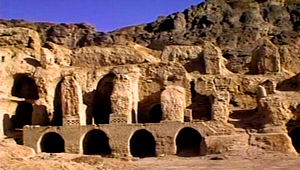 Kapilavastu, the capital city of Sakya clan, is now known as Piprahwa. It is 110 km from Gorakhpur in Uttar Pradesh. Prince Siddhartha spent his childhood at this place. At Kapilavastu, he witnessed sorrow of a beggar, sadness of an old man, pain of a sick and a dead body. After all these events, he finally decided to renounce all the worldly pleasure and search for the truth and salvation. Kapilavastu, the capital city of Sakya clan, is now known as Piprahwa. It is 110 km from Gorakhpur in Uttar Pradesh. Prince Siddhartha spent his childhood at this place. At Kapilavastu, he witnessed sorrow of a beggar, sadness of an old man, pain of a sick and a dead body. After all these events, he finally decided to renounce all the worldly pleasure and search for the truth and salvation.On Kapilavastu Tours, there are quite a few interesting things to see. The 5th century AD Chinese pilgrim Fa-Hien described Kapilavastu as a "great scene of empty desolation". A few monks, a few families and animals such as lions and white elephants habitat it. Between 1971 and 1977, Archaeological Survey of India carried out an excavation at Kapilavastu. Of the stupas and inscription of Kushana period excavated from the site, one stupa was referred to as the Eastern Stupa by the archaeologists. The inscription on it read "The Devaputra Vihara of the Kapilavastu Bhikkhu Sangha" On Kapilavastu Tour, you will find the two excavated mounds at a distance of 1.5 km from the excavated site are. The larger of the two is a thick walled structure. The locals believe that it was a Suddhodana's Palace. A small Sri Lankan Monastery and Temple and Mahinda Mahavihara are also nearby these ruins. |
|
Kaushambi |
Top^ |
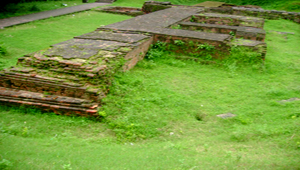 In the times of Lord Buddha Kaushambi was the ancient kingdom of Matsya. It has been a grand center of Buddhist culture and heritage. Kaushambi is about 57 km far from the modern Allahabad. The ancient name of Kaushambi was Kosam. The place Kaushambi is now turned into ruins due to the negligence of later rulers. But still some old forts, Stupas and Sculptures of Kaushambi attract huge number of travelers every year. Kaushambi is a famous pilgrimage site as lord Buddha spent his sixth and ninth year after attaining enlightenment. India tour provides you the facility to witness this fascinating place in Uttar Pradesh. In the times of Lord Buddha Kaushambi was the ancient kingdom of Matsya. It has been a grand center of Buddhist culture and heritage. Kaushambi is about 57 km far from the modern Allahabad. The ancient name of Kaushambi was Kosam. The place Kaushambi is now turned into ruins due to the negligence of later rulers. But still some old forts, Stupas and Sculptures of Kaushambi attract huge number of travelers every year. Kaushambi is a famous pilgrimage site as lord Buddha spent his sixth and ninth year after attaining enlightenment. India tour provides you the facility to witness this fascinating place in Uttar Pradesh. |
|
Kushinagar |
Top^ |
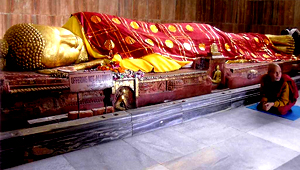 Kushinagar is where the Buddha finally attained Mahaparinirvana. Amongst the ruins are the Mukut bandhan Stupa and a beautiful statue of the reclining Buddha. Kushinagar is where the Buddha finally attained Mahaparinirvana. Amongst the ruins are the Mukut bandhan Stupa and a beautiful statue of the reclining Buddha. At Gorakhpur, en-route to Kushinagar, there is the Rahul Sankrityayan Museum with a collection of thangka paintings. An inscribed relic casket was dug out of the ruins of a stupa at Piprahwa, now identified as Kapilavastu.ermon. |
|
Ladakh |
Top^ |
 Ladakh is a land like no other. Bounded by two of the world's mightiest mountain ranges, the Great Himalaya and the Karakoram, it lies athwart two other, the Ladakh range and the Zanskar range. Ladakh is a land like no other. Bounded by two of the world's mightiest mountain ranges, the Great Himalaya and the Karakoram, it lies athwart two other, the Ladakh range and the Zanskar range.In geological terms, this is a young land, formed only a few million years ago by the buckling and folding of the earth's crust as the Indian sub-continent pushed with irresistible force against the immovable mass of Asia. Its basic contours, uplifted by these unimaginable tectonic movements, have been modified over the millennia by the opposite process of erosion, sculpted into the form we see today by wind and water. Yes, water! Today, a high -altitude desert, sheltered from the rain-bearing clouds of the Indian monsoon by the barrier of the Great Himalaya, Ladakh was once covered by an extensive lake system, the vestiges of which still exist on its south -east plateaux of Rupshu and Chushul - in drainage basins with evocative names like Tso-moriri, Tsokar, and grandest of all, Pangong-tso. Occasionally, some stray monsoon clouds do find their way over the Himalaya, and lately this seems to be happening with increasing frequency. But the main source of water remains the winter snowfall. Drass, Zanskar and the Suru Valley on the Himalaya's northern flank receive heavy snow in winter; this feeds the glaciers whose meltwater, carried down by streams, irrigates the fields in summer. For the rest of the region, the snow on the peaks is virtually the only source of water. As the crops grow, the villagers pray not for rain, but for sun to melt the glaciers and liberate their water. Usually their prayers are answered, for the skies are clear and the sun shines for over 300 days in the year. |
|
vaishali |
Top^ |
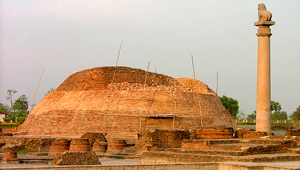 Five years after the Enlightenment in Bodh Gaya, Lord Buddha came to Vaishali, the capital of one of the first republican states in the world.
Situated on the northern banks of the Ganga, Vaishali is bound by the hills of Nepal on the north and the river Gandak on the west. The Lichchavi nobility came to receive the Enlightened One with a cavalcade of elephants and chariots bedecked with gold. As the Lord set foot on the soil of Vaishali, loud thunder followed by a heavy downpour purged the plague-infected city.
The Buddha preached the Ratna Sutra to those assembled, and eightyfour thousand people embraced the new faith. In Vaishali for the first time women were ordained into the Sangha. The Buddha's foster mother, Mahaprajapati Gautami, along with 500 Sakyan women made a pilgrimage by foot from Kapilavastu to Vaishali, seeking to join the Order. Three times the Lord refused their entreaties. Ultimately they shaved their heads, donned the orange robes and beseeched the Lord once again. The Enlightened One was finally persuaded to admit the women as bhikshunis or nuns. Five years after the Enlightenment in Bodh Gaya, Lord Buddha came to Vaishali, the capital of one of the first republican states in the world.
Situated on the northern banks of the Ganga, Vaishali is bound by the hills of Nepal on the north and the river Gandak on the west. The Lichchavi nobility came to receive the Enlightened One with a cavalcade of elephants and chariots bedecked with gold. As the Lord set foot on the soil of Vaishali, loud thunder followed by a heavy downpour purged the plague-infected city.
The Buddha preached the Ratna Sutra to those assembled, and eightyfour thousand people embraced the new faith. In Vaishali for the first time women were ordained into the Sangha. The Buddha's foster mother, Mahaprajapati Gautami, along with 500 Sakyan women made a pilgrimage by foot from Kapilavastu to Vaishali, seeking to join the Order. Three times the Lord refused their entreaties. Ultimately they shaved their heads, donned the orange robes and beseeched the Lord once again. The Enlightened One was finally persuaded to admit the women as bhikshunis or nuns. |
|
Lumbini |
Top^ |
 Lumbini, the birthplace of the Buddha, was located in 1890 after being untraced for 1,500 years. Lumbini, the birthplace of the Buddha, was located in 1890 after being untraced for 1,500 years.Lumbini grove, the sacred site of Lord Buddha's birth is today a small village in Nepal, 27 kms from Sonauli on the Indo-Nepal Border. Three hundred years after the Mahaparinirvana, Emperor Ashoka visited Lumbini and erected a pillar there. This pillar, though broken, still remains at the site. It is known as the Rummendei Pillar after the earlier name of the place (modern name Rupandhei)in Nepal. |
|
Nalanda |
Top^ |
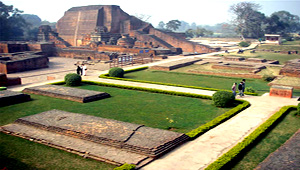 Nalanda was the most renowned university in ancient India. It derived its name from Na-alam-da, meaning Insatiable in Giving, one of the names by which the Lord Buddha was known. Nalanda was the most renowned university in ancient India. It derived its name from Na-alam-da, meaning Insatiable in Giving, one of the names by which the Lord Buddha was known.Established in the 5th century B.C. it remained a live center of learning till the 12th century A.D. when it was destroyed by the invader Bakhtiar Khilji. Lord Mahavira and the Buddha both taught here for years. Hsuan Tsang. the Chinese traveler studied here in the 7th century A.D. and there is a monument in his memory. He was one amongst many of those from East and Southeast Asia who came here to study logic, meta-physics, medicine, prose composition and rhetoric. The university of Nalanda offered free educational and residential facilities to as many as 10,000 students and 2000 teachers, for it was supported by a number of villages. Its library, Ratna Sagar, is believed to have contained nine million volumes. It is not surprising, then, that the destruction of this university dealt a crippling blow to Buddhist education in India. The Archaeological Survey of India maintains the Nalanda Museum across the road which houses some exquisite bronzes of the 9th and 10th centuries, Pala dynasty, and other remains excavated at the site.The beautiful Thai Temple and the Nava Nalanda Mahavihara, a centre for research in Pali and Buddhist studies, are 2 kms from the main site. |
|
Nagarjunakonda |
Top^ |
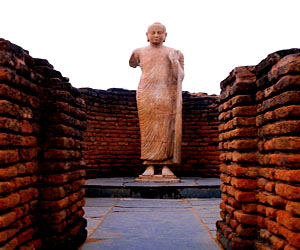 The excavated remains of the Buddhist civilization have been reconstructed and are carefully preserved at Nagarjunakonda, a unique Island museum, situated in the midst of the man-made Nagarjunasagar lake.
Constructed In the shape of a Buddhist Vihara, the museum houses a stupendous collection of relics of Buddhist art and culture. Famous relics include a small tooth and an ear-ring believed to be of the Buddha. The main stupa of Nagarjunakonda called Mahachaitya is believed to contain the sacred relics of lhe Buddha. A partly ruined monolithic statue of the Buddha, that's at once a striking-image of peace and poise, is the main attraction at the museum.
The monasteries and chaityas were reconstructed on top of a hill called Nagarjunakonda (konda is the Telgu word for hill), which rises from the middle of the lake. The island takes its name from the Buddhist monk, Nagarjuna, who lived around the turn of the 2nd century AD and was the exponent of the philosophy of sunyata (void). Statues, friezes, coins and jewellery found at the site are housed in a museum on the island and give a fascinating insight into the daily lives of this ancient Buddhist centre. Earlier it used to be known as Vijayapur. The site was discovered in 1926. Subsequent excavations, particularly in the '50s and '60s, have unearthed the remains of stupas, viharas, chaityas and mandapams. The excavated remains of the Buddhist civilization have been reconstructed and are carefully preserved at Nagarjunakonda, a unique Island museum, situated in the midst of the man-made Nagarjunasagar lake.
Constructed In the shape of a Buddhist Vihara, the museum houses a stupendous collection of relics of Buddhist art and culture. Famous relics include a small tooth and an ear-ring believed to be of the Buddha. The main stupa of Nagarjunakonda called Mahachaitya is believed to contain the sacred relics of lhe Buddha. A partly ruined monolithic statue of the Buddha, that's at once a striking-image of peace and poise, is the main attraction at the museum.
The monasteries and chaityas were reconstructed on top of a hill called Nagarjunakonda (konda is the Telgu word for hill), which rises from the middle of the lake. The island takes its name from the Buddhist monk, Nagarjuna, who lived around the turn of the 2nd century AD and was the exponent of the philosophy of sunyata (void). Statues, friezes, coins and jewellery found at the site are housed in a museum on the island and give a fascinating insight into the daily lives of this ancient Buddhist centre. Earlier it used to be known as Vijayapur. The site was discovered in 1926. Subsequent excavations, particularly in the '50s and '60s, have unearthed the remains of stupas, viharas, chaityas and mandapams. |
|
Nagarjuna sagar |
Top^ |
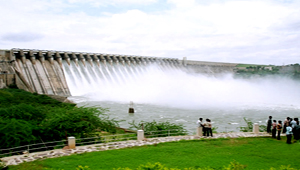 Nagarjuna Sagar called 'Vijayapuri' in ancient times is an important Buddhist site located 150 kms from Hyderabad. Nagarjuna Sagar called 'Vijayapuri' in ancient times is an important Buddhist site located 150 kms from Hyderabad. Nagarjunasagar is named after the Buddhist saint Acharya Nagarjuna, one of the outstanding Buddhist teachers in the Andhra Kingdom. The relics of Buddhist civilisation dating back to the 3rd Century A.D. that were excavated here are carefully preserved on the picturesque island Nagarjuna konda situated in the centre of a man-made lake. The Nagarjunasagar Dam is the tallest masonry dam in the World. The Museum at Nagarjunakonda, which displays relics also has pre-historic finds in the form of tools from paleolithic and neolithic times. |
|
Orissa & Buddhism |
Top^ |
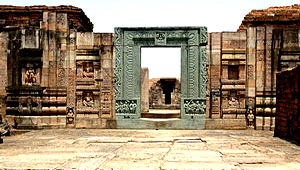 Dating from 260 BC the Dhauli edicts give detailed instructions to Ashoka's administrators to rule his subjects with gentleness and fairness. Dating from 260 BC the Dhauli edicts give detailed instructions to Ashoka's administrators to rule his subjects with gentleness and fairness. Driving down the Puri-Konark Highway from Bhubaneshwar one comes across Dhauli hill on the banks of the River Daya. Surrounded by the soothing greenery of paddy fields, lies the 3rd Century BC Ashokan Rock Edict, a memory of the gruesome war that transformed Ashoka, the great Warrior into a Buddhist missionary. The Peace Pagoda built in collaboration with the Kalinga - Japanese Buddhist Sangha, on the opposite hill, is completely modern and is an excellent foil. Lalitagiri - Ratnagiri - Udaygiri |
|
Rajgir |
Top^ |
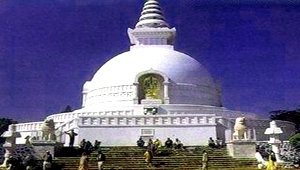 The picturesque Rajgir, or Rajagriha as it was known in the past (literally, the abode of kings) is surrounded by the meandering river Banganga and 5 hills. The picturesque Rajgir, or Rajagriha as it was known in the past (literally, the abode of kings) is surrounded by the meandering river Banganga and 5 hills.During the lifetime of the Buddha this was the capital of the powerful Magadhan kingdom, ruled by the virtuous King Bimbisara. The hills and caves surrounding Rajagriha were home to spiritual teachers, ranging from the materialism of the early Charavaka school to the metaphysics of Upanishadic philosophers. Like many others in search of truth, Prince Siddhartha, after he renounced his royal heritage came to this city to seek the path of vation. Siddhartha overwhelmed the citizens of Rajagriha with his serenity and grace. Even the king went to meet the ascetic and was amazed to learn that he was a kshatriya of royal descent. Bimbisara offered half his kingdom to Siddhartha but all he received was an assurance that when Siddhartha achieved his gola he would return to Rajagriha. The first Buddhist structures at Rajgir were raised when Ajatsatni built a monastery, and a stupa over his share of the Buddha's ashes. That reliquary is now a mound used as a graveyard. The Japanese much later have built the World Peace Stupa, with its gilded images of the Buddha. Rajgir also has the Nipponzan Myohoji, the Japanese temple, and the Centaur Hokke Club which offers some traditional facilities to Japanese pilgrims. |
|
Sanchi |
Top^ |
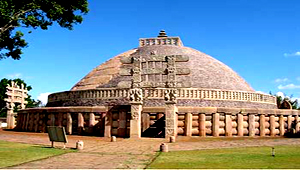 Sanchi is a serene hill crowned by a group of stupas, monasteries, temples and pillars dating from 3rd Century BC to the 12th Century AD. The glory that was Sanchi, an ancient seat of Buddhist learning and place of pilgrimage, can still be experienced in its complex structures where many Buddhist legends found expression in the rich sculpture. Sanchi is a serene hill crowned by a group of stupas, monasteries, temples and pillars dating from 3rd Century BC to the 12th Century AD. The glory that was Sanchi, an ancient seat of Buddhist learning and place of pilgrimage, can still be experienced in its complex structures where many Buddhist legends found expression in the rich sculpture.Sanchi is little more than a small village at the foot of the hill on which the site is located. The Buddhist sites of Sanchi were included on the World heritage List in 1989. The Buddha is not represented through figures at Sanchi, but through symbols, as was the tradition in the early period of Buddhism. The lotus represents the Buddha's birth, the tree signifies his enlightenment, the wheel represents his first sermon and the stupa represents his nirvana or salvation. The footprints and the throne denote the Buddha's presence. |
|
Sankisa |
Top^ |
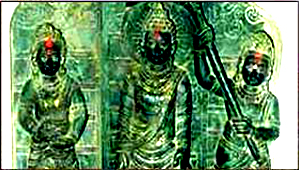 Sankisa lies in central Uttar Pradesh, 47 kms from Farrukhabad. It is believed to be the place where Buddha, along with Brahma and Devraj Indra descended after giving sermons to his mother in heaven. Sankisa lies in central Uttar Pradesh, 47 kms from Farrukhabad. It is believed to be the place where Buddha, along with Brahma and Devraj Indra descended after giving sermons to his mother in heaven.At the spot of descent stands a temple with a statue of the Buddha. The place is also known for a temple dedicated to Bisari Devi and an excavated Ashokan Elephant Pillar. There is also a collosal Shiva Linga here. A large fair is held at Sankisa in the month of Shravan (July-August). |
|
Sarnath |
Top^ |
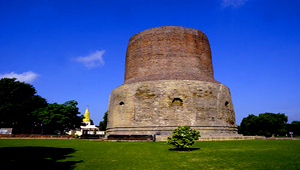 Sarnath, where the Buddha preached his first sermon in the Deer Park, contains the most impressive remains, as well as a modem temple. Sarnath, where the Buddha preached his first sermon in the Deer Park, contains the most impressive remains, as well as a modem temple.The Dharmarajika, Chaukhandi and Dharnek stupas are outstanding. There are also the remains of a monastery, and the beautifully polished Lion Capital of Ashoka. Sarnath contains a rich library and at the Mula gandha Kutir Vihara there are excellent frescoes by Kosetsu Nosu. The Sarnath Museum, not far from the site, contains some of the finest specimens of Buddhist sculpture. At all centers of Buddhist worship, the Vaisakha (April-May) full moon is observed as the anniversary of three important events - the Buddha's birth, Enlightenment and death, while the Asadh (July - August) full moon is observed as the anniversary of his first sermon. |
|
Sikkim |
Top^ |
 Sikkim is situated in the Eastern Himalayas, along the borders of Bhutan (East), Tibet (North),Nepal (West) and West Bengal (South). Sikkim is situated in the Eastern Himalayas, along the borders of Bhutan (East), Tibet (North),Nepal (West) and West Bengal (South).Its capital, Gangtokhas a lot to see, specially the Research Institute of Tibetology, a World centre for the study of Buddhist philosophy & religion and has a rare collection of Thankas, statues and over 200 Buddhist icons, 24kms away, you approach the Rumtek Monastery which houses among the most unique art objects in the world. 3 kms from Gangtok is the Enchey Monastery built almost 200 years ago and was blessed by the great tantric master Lama Druptab Karpa. |
|
Ajanta & Ellora |
Top^ |
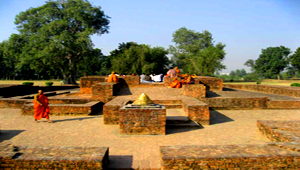 Ajanta and Ellora Caves are the ancient repository of Indian architectural heritage. Located near the city of Aurangabad in Maharashtra Ajanta and Ellora caves are the world famous for the cave shrines that cut out of rock, all by hand. There are 34 caves at Ellora and 29 caves at Ajanta. And all are sheer outstanding specimens of Indian architectural excellence. Ajanta and Ellora Caves are the ancient repository of Indian architectural heritage. Located near the city of Aurangabad in Maharashtra Ajanta and Ellora caves are the world famous for the cave shrines that cut out of rock, all by hand. There are 34 caves at Ellora and 29 caves at Ajanta. And all are sheer outstanding specimens of Indian architectural excellence.The intriguing Ajanta Caves are carved out of large rocks and are 30 in number. These caves are dedicated to Lord Buddha. The followers and students of Buddhism resided here to study this religion. They have decorated these caves with the help of their excellent architectural skills and artistic paintings. The carvings and the paintings in the caves depict the life stories of Lord Buddha. Along with this, several types of human and animal figures are also carved out of the rocks. * Depiction of Contemporary Society * The Caves * The Viharas * The Chaityas * The Wall-Paintings |
|
Tabo |
Top^ |
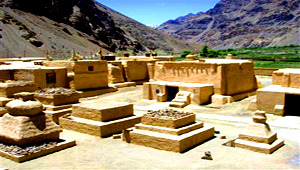 Tabo is located at a height of 3050 metres in the magnificently isolated Spiti valley in Himachal Pradesh. Tabo is located at a height of 3050 metres in the magnificently isolated Spiti valley in Himachal Pradesh.Founded in 996 AD by the great scholar, Rinchensang Po, as an institution for advanced learning, Tabo celebrated its 1000th anniversary in 1996. Unlike most other monasteries in the Western Himalayas, Tabo stands on barren, flat ground and is built with mud brick. With breathtaking murals and stucco images, Tabo is often called 'The Ajanta of the Himalayas'. And here is the art that above all, is born of religion and deep faith. A small community of sixty monks resides here. The monastery has clay statues of the Buddha painted in the Kashmiri style. |
|
Tawang |
Top^ |
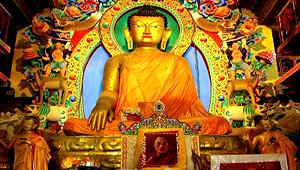 Tawang Gompa is a 400 year old monastery which is a dominant feature of the valley and commands a grand view of the Himalayas. It is situated at an altitude of more than
3000 m. Tawang Gompa is a 400 year old monastery which is a dominant feature of the valley and commands a grand view of the Himalayas. It is situated at an altitude of more than
3000 m. It has elaborately painted wooden windows and other motifs. Prayer flags flutter in the breeze. Inside there is a 8 meter high gilded statue of the Buddha and numerous ancient Thankas or traditional paintings and manuscripts. Tawang stands isolated from the rest of the world with its community of 500 lamas peacefully performing their daily rituals. Though difficult to reach, Tawang continues to attract scholars and pilgrims. The main attractions are a gigantic 10 metre statue of the Buddha, the large collection of priceless manuscripts, books and tangkhas, which depict the Buddha and tutelary deities in differnet poses. |
|